Business Organization: Objectives, Structures, and Franchises
VerifiedAdded on 2020/10/05
|10
|2634
|199
Report
AI Summary
This report provides an introduction to business organizations, exploring their key objectives, ownership structures, and the role of franchises. It begins by analyzing the objectives of various business types, including sole traders, partnerships, and limited companies, highlighting their unique goals and strategies. The report then delves into the ownership structures of sole traders and limited companies, contrasting their operational differences and liabilities. Furthermore, it examines the key features of a franchise within an organization, detailing its benefits such as industry experience, marketing support, and risk diversification. The report concludes by summarizing the advantages of franchises for business organizations, emphasizing their role in building strong relationships and achieving large turnovers. This comprehensive analysis provides a clear understanding of business organization principles.
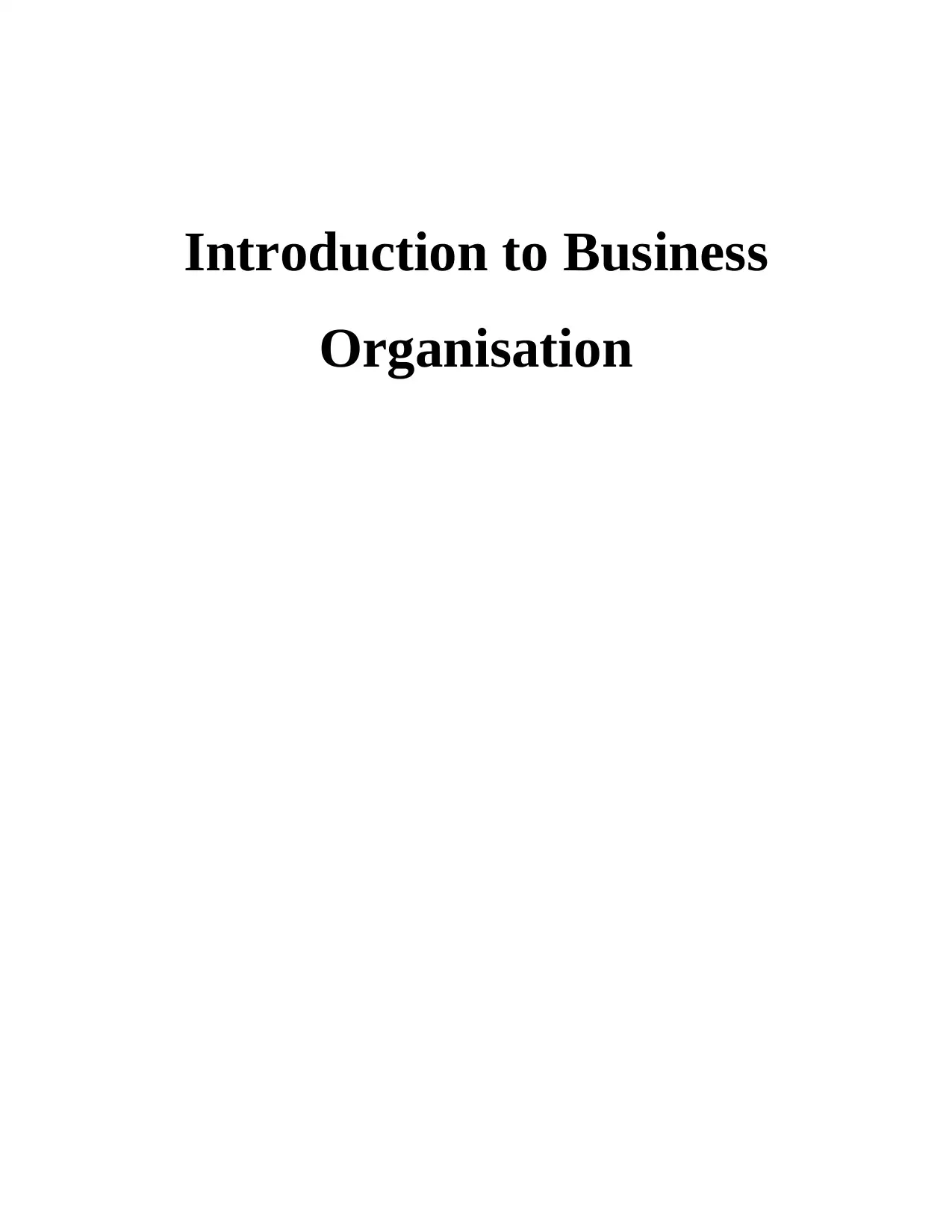
Introduction to Business
Organisation
Organisation
Paraphrase This Document
Need a fresh take? Get an instant paraphrase of this document with our AI Paraphraser
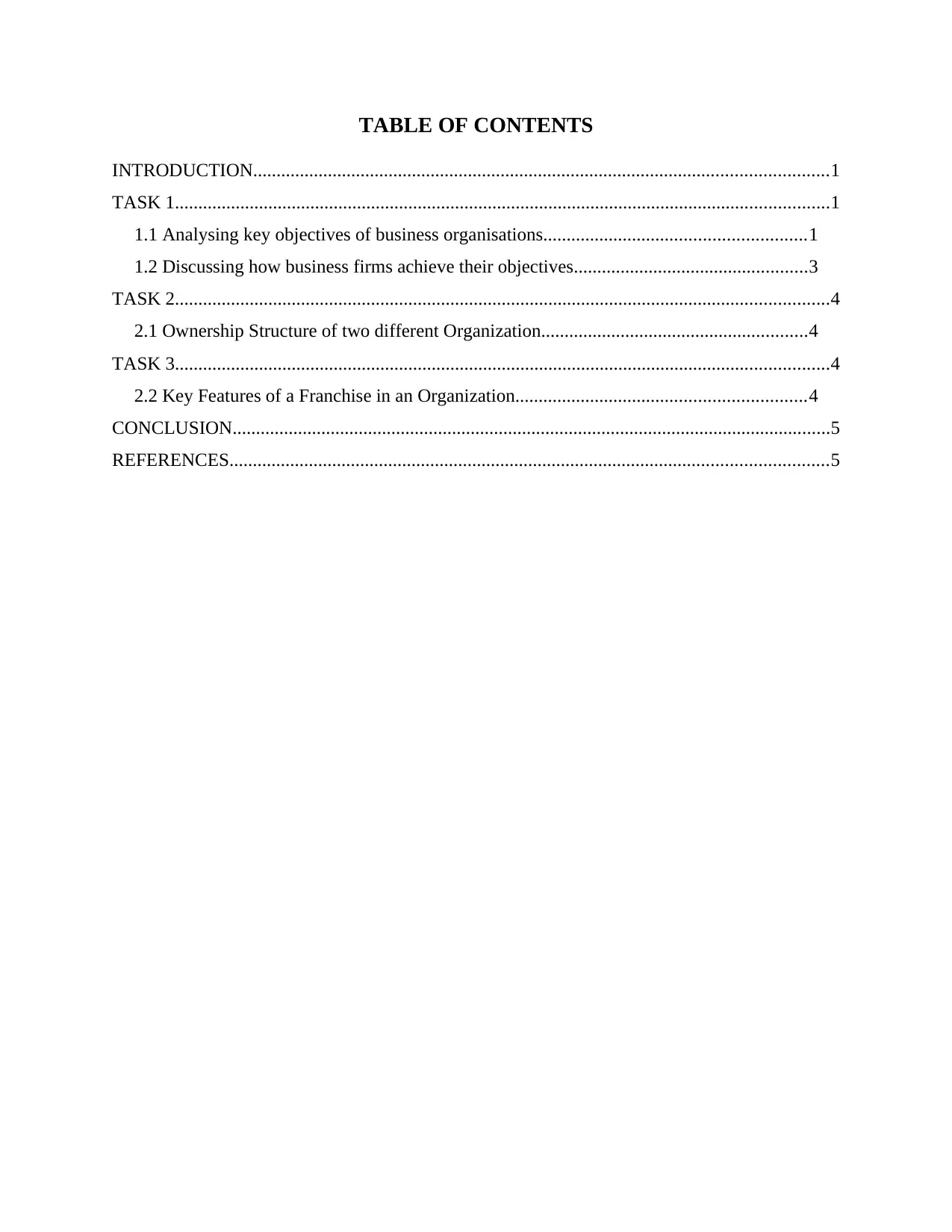
TABLE OF CONTENTS
INTRODUCTION...........................................................................................................................1
TASK 1............................................................................................................................................1
1.1 Analysing key objectives of business organisations........................................................1
1.2 Discussing how business firms achieve their objectives..................................................3
TASK 2............................................................................................................................................4
2.1 Ownership Structure of two different Organization.........................................................4
TASK 3............................................................................................................................................4
2.2 Key Features of a Franchise in an Organization..............................................................4
CONCLUSION................................................................................................................................5
REFERENCES................................................................................................................................5
INTRODUCTION...........................................................................................................................1
TASK 1............................................................................................................................................1
1.1 Analysing key objectives of business organisations........................................................1
1.2 Discussing how business firms achieve their objectives..................................................3
TASK 2............................................................................................................................................4
2.1 Ownership Structure of two different Organization.........................................................4
TASK 3............................................................................................................................................4
2.2 Key Features of a Franchise in an Organization..............................................................4
CONCLUSION................................................................................................................................5
REFERENCES................................................................................................................................5
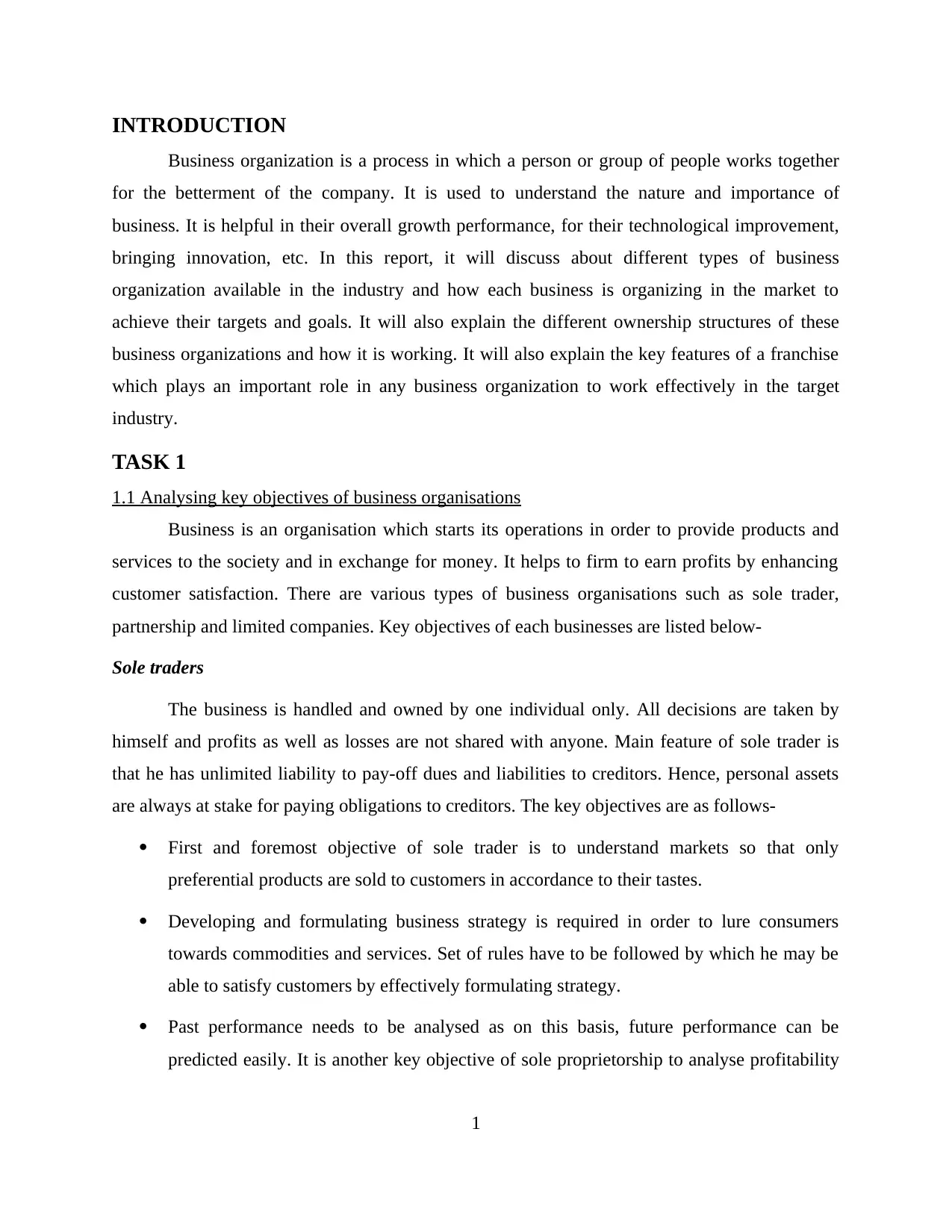
INTRODUCTION
Business organization is a process in which a person or group of people works together
for the betterment of the company. It is used to understand the nature and importance of
business. It is helpful in their overall growth performance, for their technological improvement,
bringing innovation, etc. In this report, it will discuss about different types of business
organization available in the industry and how each business is organizing in the market to
achieve their targets and goals. It will also explain the different ownership structures of these
business organizations and how it is working. It will also explain the key features of a franchise
which plays an important role in any business organization to work effectively in the target
industry.
TASK 1
1.1 Analysing key objectives of business organisations
Business is an organisation which starts its operations in order to provide products and
services to the society and in exchange for money. It helps to firm to earn profits by enhancing
customer satisfaction. There are various types of business organisations such as sole trader,
partnership and limited companies. Key objectives of each businesses are listed below-
Sole traders
The business is handled and owned by one individual only. All decisions are taken by
himself and profits as well as losses are not shared with anyone. Main feature of sole trader is
that he has unlimited liability to pay-off dues and liabilities to creditors. Hence, personal assets
are always at stake for paying obligations to creditors. The key objectives are as follows-
First and foremost objective of sole trader is to understand markets so that only
preferential products are sold to customers in accordance to their tastes.
Developing and formulating business strategy is required in order to lure consumers
towards commodities and services. Set of rules have to be followed by which he may be
able to satisfy customers by effectively formulating strategy.
Past performance needs to be analysed as on this basis, future performance can be
predicted easily. It is another key objective of sole proprietorship to analyse profitability
1
Business organization is a process in which a person or group of people works together
for the betterment of the company. It is used to understand the nature and importance of
business. It is helpful in their overall growth performance, for their technological improvement,
bringing innovation, etc. In this report, it will discuss about different types of business
organization available in the industry and how each business is organizing in the market to
achieve their targets and goals. It will also explain the different ownership structures of these
business organizations and how it is working. It will also explain the key features of a franchise
which plays an important role in any business organization to work effectively in the target
industry.
TASK 1
1.1 Analysing key objectives of business organisations
Business is an organisation which starts its operations in order to provide products and
services to the society and in exchange for money. It helps to firm to earn profits by enhancing
customer satisfaction. There are various types of business organisations such as sole trader,
partnership and limited companies. Key objectives of each businesses are listed below-
Sole traders
The business is handled and owned by one individual only. All decisions are taken by
himself and profits as well as losses are not shared with anyone. Main feature of sole trader is
that he has unlimited liability to pay-off dues and liabilities to creditors. Hence, personal assets
are always at stake for paying obligations to creditors. The key objectives are as follows-
First and foremost objective of sole trader is to understand markets so that only
preferential products are sold to customers in accordance to their tastes.
Developing and formulating business strategy is required in order to lure consumers
towards commodities and services. Set of rules have to be followed by which he may be
able to satisfy customers by effectively formulating strategy.
Past performance needs to be analysed as on this basis, future performance can be
predicted easily. It is another key objective of sole proprietorship to analyse profitability
1
⊘ This is a preview!⊘
Do you want full access?
Subscribe today to unlock all pages.

Trusted by 1+ million students worldwide
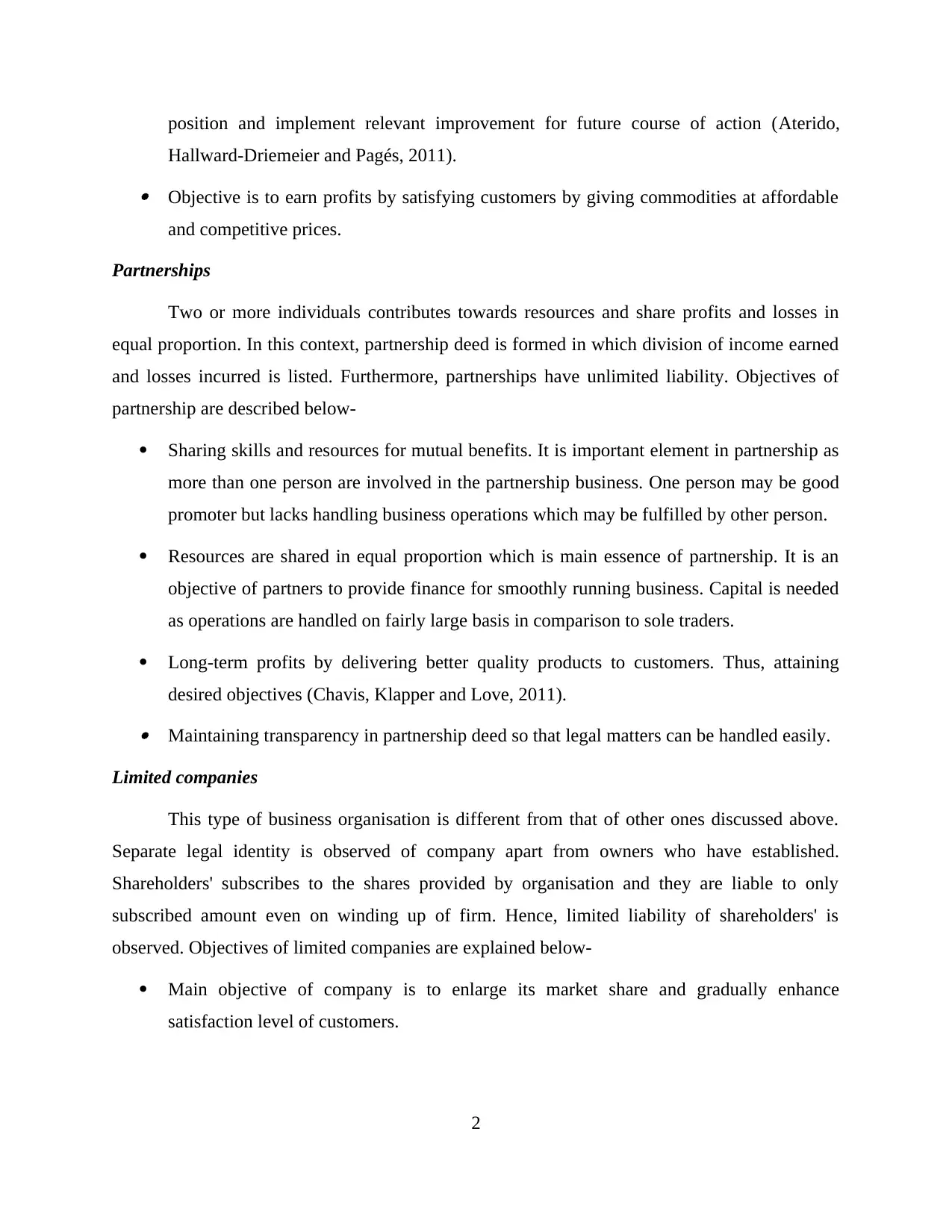
position and implement relevant improvement for future course of action (Aterido,
Hallward-Driemeier and Pagés, 2011). Objective is to earn profits by satisfying customers by giving commodities at affordable
and competitive prices.
Partnerships
Two or more individuals contributes towards resources and share profits and losses in
equal proportion. In this context, partnership deed is formed in which division of income earned
and losses incurred is listed. Furthermore, partnerships have unlimited liability. Objectives of
partnership are described below-
Sharing skills and resources for mutual benefits. It is important element in partnership as
more than one person are involved in the partnership business. One person may be good
promoter but lacks handling business operations which may be fulfilled by other person.
Resources are shared in equal proportion which is main essence of partnership. It is an
objective of partners to provide finance for smoothly running business. Capital is needed
as operations are handled on fairly large basis in comparison to sole traders.
Long-term profits by delivering better quality products to customers. Thus, attaining
desired objectives (Chavis, Klapper and Love, 2011). Maintaining transparency in partnership deed so that legal matters can be handled easily.
Limited companies
This type of business organisation is different from that of other ones discussed above.
Separate legal identity is observed of company apart from owners who have established.
Shareholders' subscribes to the shares provided by organisation and they are liable to only
subscribed amount even on winding up of firm. Hence, limited liability of shareholders' is
observed. Objectives of limited companies are explained below-
Main objective of company is to enlarge its market share and gradually enhance
satisfaction level of customers.
2
Hallward-Driemeier and Pagés, 2011). Objective is to earn profits by satisfying customers by giving commodities at affordable
and competitive prices.
Partnerships
Two or more individuals contributes towards resources and share profits and losses in
equal proportion. In this context, partnership deed is formed in which division of income earned
and losses incurred is listed. Furthermore, partnerships have unlimited liability. Objectives of
partnership are described below-
Sharing skills and resources for mutual benefits. It is important element in partnership as
more than one person are involved in the partnership business. One person may be good
promoter but lacks handling business operations which may be fulfilled by other person.
Resources are shared in equal proportion which is main essence of partnership. It is an
objective of partners to provide finance for smoothly running business. Capital is needed
as operations are handled on fairly large basis in comparison to sole traders.
Long-term profits by delivering better quality products to customers. Thus, attaining
desired objectives (Chavis, Klapper and Love, 2011). Maintaining transparency in partnership deed so that legal matters can be handled easily.
Limited companies
This type of business organisation is different from that of other ones discussed above.
Separate legal identity is observed of company apart from owners who have established.
Shareholders' subscribes to the shares provided by organisation and they are liable to only
subscribed amount even on winding up of firm. Hence, limited liability of shareholders' is
observed. Objectives of limited companies are explained below-
Main objective of company is to enlarge its market share and gradually enhance
satisfaction level of customers.
2
Paraphrase This Document
Need a fresh take? Get an instant paraphrase of this document with our AI Paraphraser
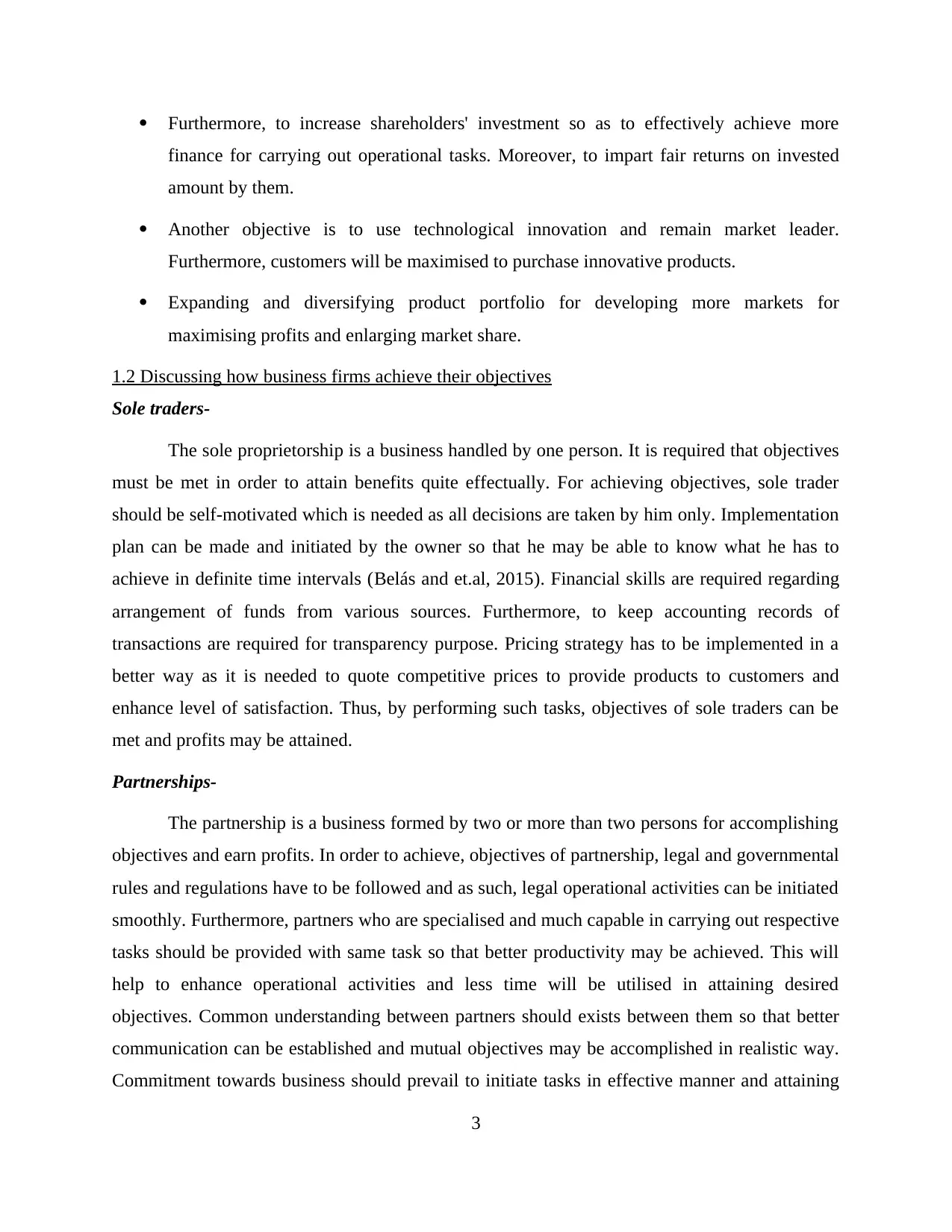
Furthermore, to increase shareholders' investment so as to effectively achieve more
finance for carrying out operational tasks. Moreover, to impart fair returns on invested
amount by them.
Another objective is to use technological innovation and remain market leader.
Furthermore, customers will be maximised to purchase innovative products.
Expanding and diversifying product portfolio for developing more markets for
maximising profits and enlarging market share.
1.2 Discussing how business firms achieve their objectives
Sole traders-
The sole proprietorship is a business handled by one person. It is required that objectives
must be met in order to attain benefits quite effectually. For achieving objectives, sole trader
should be self-motivated which is needed as all decisions are taken by him only. Implementation
plan can be made and initiated by the owner so that he may be able to know what he has to
achieve in definite time intervals (Belás and et.al, 2015). Financial skills are required regarding
arrangement of funds from various sources. Furthermore, to keep accounting records of
transactions are required for transparency purpose. Pricing strategy has to be implemented in a
better way as it is needed to quote competitive prices to provide products to customers and
enhance level of satisfaction. Thus, by performing such tasks, objectives of sole traders can be
met and profits may be attained.
Partnerships-
The partnership is a business formed by two or more than two persons for accomplishing
objectives and earn profits. In order to achieve, objectives of partnership, legal and governmental
rules and regulations have to be followed and as such, legal operational activities can be initiated
smoothly. Furthermore, partners who are specialised and much capable in carrying out respective
tasks should be provided with same task so that better productivity may be achieved. This will
help to enhance operational activities and less time will be utilised in attaining desired
objectives. Common understanding between partners should exists between them so that better
communication can be established and mutual objectives may be accomplished in realistic way.
Commitment towards business should prevail to initiate tasks in effective manner and attaining
3
finance for carrying out operational tasks. Moreover, to impart fair returns on invested
amount by them.
Another objective is to use technological innovation and remain market leader.
Furthermore, customers will be maximised to purchase innovative products.
Expanding and diversifying product portfolio for developing more markets for
maximising profits and enlarging market share.
1.2 Discussing how business firms achieve their objectives
Sole traders-
The sole proprietorship is a business handled by one person. It is required that objectives
must be met in order to attain benefits quite effectually. For achieving objectives, sole trader
should be self-motivated which is needed as all decisions are taken by him only. Implementation
plan can be made and initiated by the owner so that he may be able to know what he has to
achieve in definite time intervals (Belás and et.al, 2015). Financial skills are required regarding
arrangement of funds from various sources. Furthermore, to keep accounting records of
transactions are required for transparency purpose. Pricing strategy has to be implemented in a
better way as it is needed to quote competitive prices to provide products to customers and
enhance level of satisfaction. Thus, by performing such tasks, objectives of sole traders can be
met and profits may be attained.
Partnerships-
The partnership is a business formed by two or more than two persons for accomplishing
objectives and earn profits. In order to achieve, objectives of partnership, legal and governmental
rules and regulations have to be followed and as such, legal operational activities can be initiated
smoothly. Furthermore, partners who are specialised and much capable in carrying out respective
tasks should be provided with same task so that better productivity may be achieved. This will
help to enhance operational activities and less time will be utilised in attaining desired
objectives. Common understanding between partners should exists between them so that better
communication can be established and mutual objectives may be accomplished in realistic way.
Commitment towards business should prevail to initiate tasks in effective manner and attaining
3
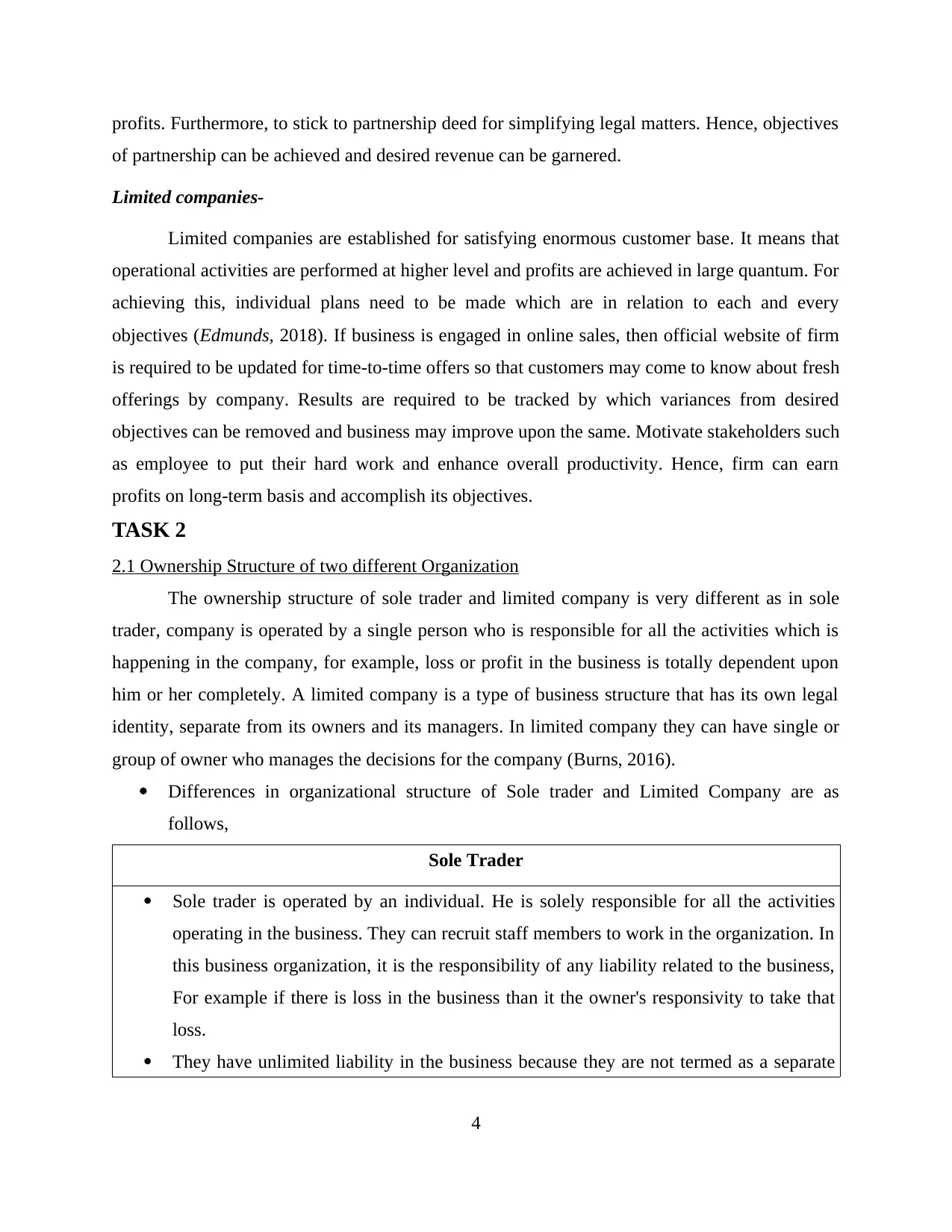
profits. Furthermore, to stick to partnership deed for simplifying legal matters. Hence, objectives
of partnership can be achieved and desired revenue can be garnered.
Limited companies-
Limited companies are established for satisfying enormous customer base. It means that
operational activities are performed at higher level and profits are achieved in large quantum. For
achieving this, individual plans need to be made which are in relation to each and every
objectives (Edmunds, 2018). If business is engaged in online sales, then official website of firm
is required to be updated for time-to-time offers so that customers may come to know about fresh
offerings by company. Results are required to be tracked by which variances from desired
objectives can be removed and business may improve upon the same. Motivate stakeholders such
as employee to put their hard work and enhance overall productivity. Hence, firm can earn
profits on long-term basis and accomplish its objectives.
TASK 2
2.1 Ownership Structure of two different Organization
The ownership structure of sole trader and limited company is very different as in sole
trader, company is operated by a single person who is responsible for all the activities which is
happening in the company, for example, loss or profit in the business is totally dependent upon
him or her completely. A limited company is a type of business structure that has its own legal
identity, separate from its owners and its managers. In limited company they can have single or
group of owner who manages the decisions for the company (Burns, 2016).
Differences in organizational structure of Sole trader and Limited Company are as
follows,
Sole Trader
Sole trader is operated by an individual. He is solely responsible for all the activities
operating in the business. They can recruit staff members to work in the organization. In
this business organization, it is the responsibility of any liability related to the business,
For example if there is loss in the business than it the owner's responsivity to take that
loss.
They have unlimited liability in the business because they are not termed as a separate
4
of partnership can be achieved and desired revenue can be garnered.
Limited companies-
Limited companies are established for satisfying enormous customer base. It means that
operational activities are performed at higher level and profits are achieved in large quantum. For
achieving this, individual plans need to be made which are in relation to each and every
objectives (Edmunds, 2018). If business is engaged in online sales, then official website of firm
is required to be updated for time-to-time offers so that customers may come to know about fresh
offerings by company. Results are required to be tracked by which variances from desired
objectives can be removed and business may improve upon the same. Motivate stakeholders such
as employee to put their hard work and enhance overall productivity. Hence, firm can earn
profits on long-term basis and accomplish its objectives.
TASK 2
2.1 Ownership Structure of two different Organization
The ownership structure of sole trader and limited company is very different as in sole
trader, company is operated by a single person who is responsible for all the activities which is
happening in the company, for example, loss or profit in the business is totally dependent upon
him or her completely. A limited company is a type of business structure that has its own legal
identity, separate from its owners and its managers. In limited company they can have single or
group of owner who manages the decisions for the company (Burns, 2016).
Differences in organizational structure of Sole trader and Limited Company are as
follows,
Sole Trader
Sole trader is operated by an individual. He is solely responsible for all the activities
operating in the business. They can recruit staff members to work in the organization. In
this business organization, it is the responsibility of any liability related to the business,
For example if there is loss in the business than it the owner's responsivity to take that
loss.
They have unlimited liability in the business because they are not termed as a separate
4
⊘ This is a preview!⊘
Do you want full access?
Subscribe today to unlock all pages.

Trusted by 1+ million students worldwide
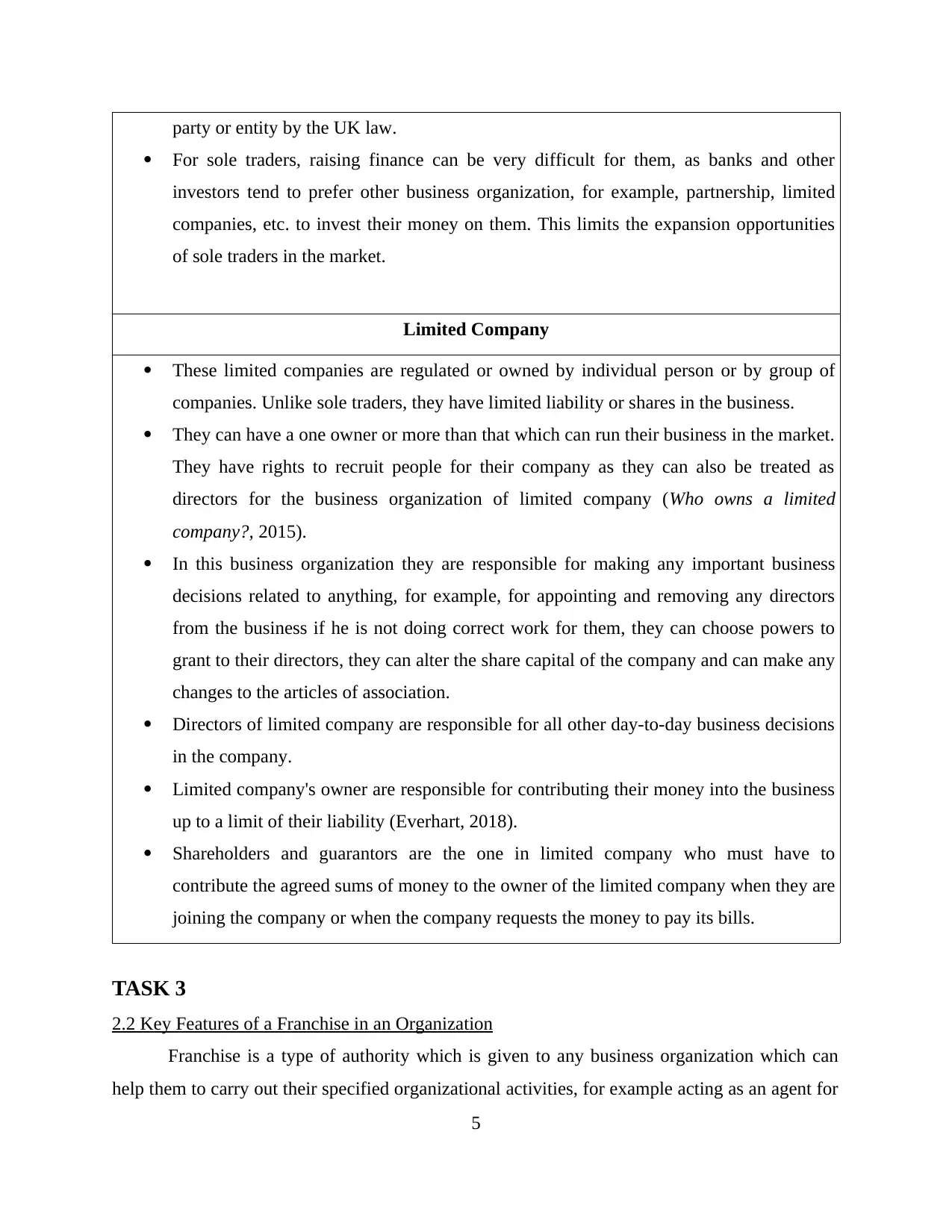
party or entity by the UK law.
For sole traders, raising finance can be very difficult for them, as banks and other
investors tend to prefer other business organization, for example, partnership, limited
companies, etc. to invest their money on them. This limits the expansion opportunities
of sole traders in the market.
Limited Company
These limited companies are regulated or owned by individual person or by group of
companies. Unlike sole traders, they have limited liability or shares in the business.
They can have a one owner or more than that which can run their business in the market.
They have rights to recruit people for their company as they can also be treated as
directors for the business organization of limited company (Who owns a limited
company?, 2015).
In this business organization they are responsible for making any important business
decisions related to anything, for example, for appointing and removing any directors
from the business if he is not doing correct work for them, they can choose powers to
grant to their directors, they can alter the share capital of the company and can make any
changes to the articles of association.
Directors of limited company are responsible for all other day-to-day business decisions
in the company.
Limited company's owner are responsible for contributing their money into the business
up to a limit of their liability (Everhart, 2018).
Shareholders and guarantors are the one in limited company who must have to
contribute the agreed sums of money to the owner of the limited company when they are
joining the company or when the company requests the money to pay its bills.
TASK 3
2.2 Key Features of a Franchise in an Organization
Franchise is a type of authority which is given to any business organization which can
help them to carry out their specified organizational activities, for example acting as an agent for
5
For sole traders, raising finance can be very difficult for them, as banks and other
investors tend to prefer other business organization, for example, partnership, limited
companies, etc. to invest their money on them. This limits the expansion opportunities
of sole traders in the market.
Limited Company
These limited companies are regulated or owned by individual person or by group of
companies. Unlike sole traders, they have limited liability or shares in the business.
They can have a one owner or more than that which can run their business in the market.
They have rights to recruit people for their company as they can also be treated as
directors for the business organization of limited company (Who owns a limited
company?, 2015).
In this business organization they are responsible for making any important business
decisions related to anything, for example, for appointing and removing any directors
from the business if he is not doing correct work for them, they can choose powers to
grant to their directors, they can alter the share capital of the company and can make any
changes to the articles of association.
Directors of limited company are responsible for all other day-to-day business decisions
in the company.
Limited company's owner are responsible for contributing their money into the business
up to a limit of their liability (Everhart, 2018).
Shareholders and guarantors are the one in limited company who must have to
contribute the agreed sums of money to the owner of the limited company when they are
joining the company or when the company requests the money to pay its bills.
TASK 3
2.2 Key Features of a Franchise in an Organization
Franchise is a type of authority which is given to any business organization which can
help them to carry out their specified organizational activities, for example acting as an agent for
5
Paraphrase This Document
Need a fresh take? Get an instant paraphrase of this document with our AI Paraphraser
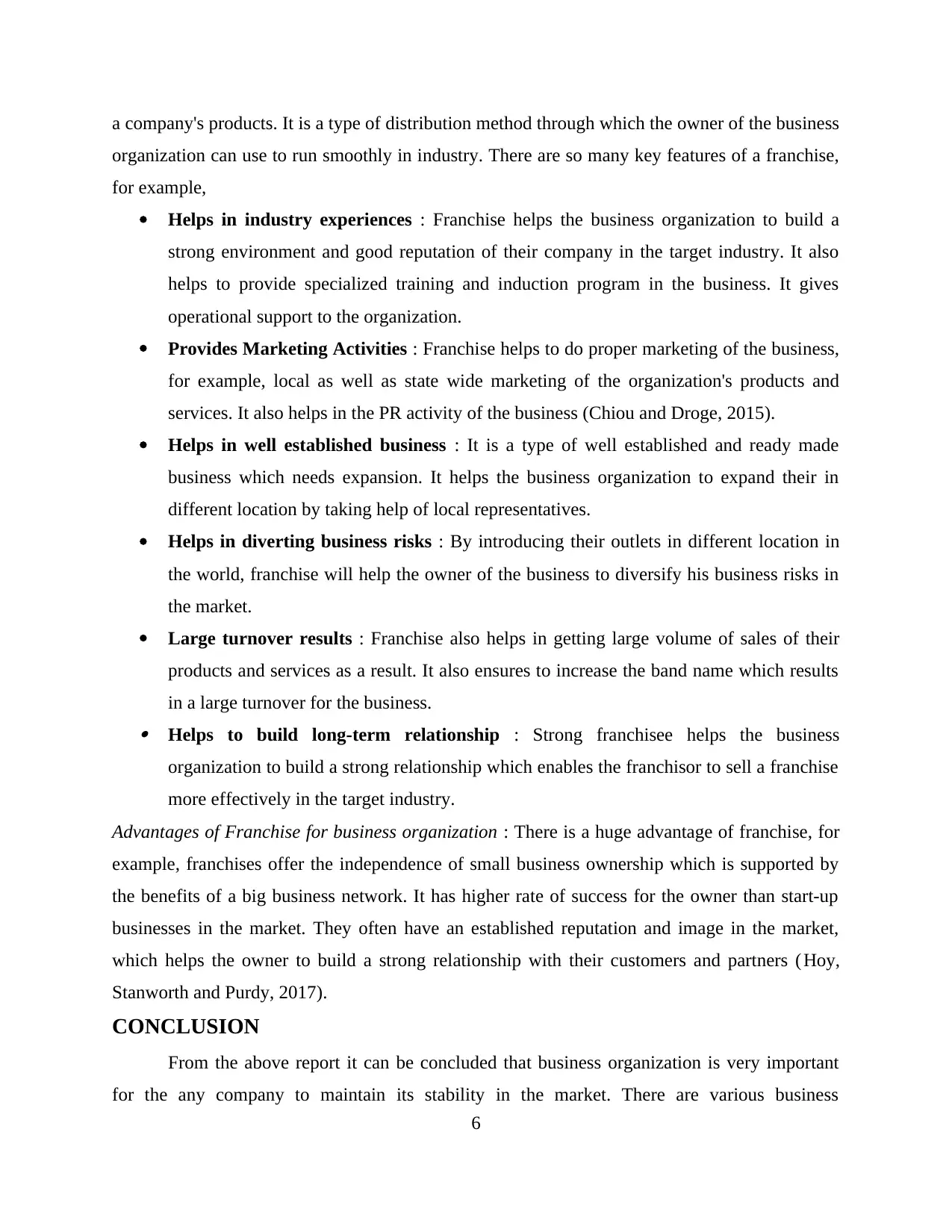
a company's products. It is a type of distribution method through which the owner of the business
organization can use to run smoothly in industry. There are so many key features of a franchise,
for example,
Helps in industry experiences : Franchise helps the business organization to build a
strong environment and good reputation of their company in the target industry. It also
helps to provide specialized training and induction program in the business. It gives
operational support to the organization.
Provides Marketing Activities : Franchise helps to do proper marketing of the business,
for example, local as well as state wide marketing of the organization's products and
services. It also helps in the PR activity of the business (Chiou and Droge, 2015).
Helps in well established business : It is a type of well established and ready made
business which needs expansion. It helps the business organization to expand their in
different location by taking help of local representatives.
Helps in diverting business risks : By introducing their outlets in different location in
the world, franchise will help the owner of the business to diversify his business risks in
the market.
Large turnover results : Franchise also helps in getting large volume of sales of their
products and services as a result. It also ensures to increase the band name which results
in a large turnover for the business. Helps to build long-term relationship : Strong franchisee helps the business
organization to build a strong relationship which enables the franchisor to sell a franchise
more effectively in the target industry.
Advantages of Franchise for business organization : There is a huge advantage of franchise, for
example, franchises offer the independence of small business ownership which is supported by
the benefits of a big business network. It has higher rate of success for the owner than start-up
businesses in the market. They often have an established reputation and image in the market,
which helps the owner to build a strong relationship with their customers and partners ( Hoy,
Stanworth and Purdy, 2017).
CONCLUSION
From the above report it can be concluded that business organization is very important
for the any company to maintain its stability in the market. There are various business
6
organization can use to run smoothly in industry. There are so many key features of a franchise,
for example,
Helps in industry experiences : Franchise helps the business organization to build a
strong environment and good reputation of their company in the target industry. It also
helps to provide specialized training and induction program in the business. It gives
operational support to the organization.
Provides Marketing Activities : Franchise helps to do proper marketing of the business,
for example, local as well as state wide marketing of the organization's products and
services. It also helps in the PR activity of the business (Chiou and Droge, 2015).
Helps in well established business : It is a type of well established and ready made
business which needs expansion. It helps the business organization to expand their in
different location by taking help of local representatives.
Helps in diverting business risks : By introducing their outlets in different location in
the world, franchise will help the owner of the business to diversify his business risks in
the market.
Large turnover results : Franchise also helps in getting large volume of sales of their
products and services as a result. It also ensures to increase the band name which results
in a large turnover for the business. Helps to build long-term relationship : Strong franchisee helps the business
organization to build a strong relationship which enables the franchisor to sell a franchise
more effectively in the target industry.
Advantages of Franchise for business organization : There is a huge advantage of franchise, for
example, franchises offer the independence of small business ownership which is supported by
the benefits of a big business network. It has higher rate of success for the owner than start-up
businesses in the market. They often have an established reputation and image in the market,
which helps the owner to build a strong relationship with their customers and partners ( Hoy,
Stanworth and Purdy, 2017).
CONCLUSION
From the above report it can be concluded that business organization is very important
for the any company to maintain its stability in the market. There are various business
6

organization available in the market, for example, sole trader, partnerships, limited company, etc.
which has unique and different ownership structure in which they operate. This report will also
discuss about different key features which a franchise has to follow in the business organization
as they play an important role for them.
7
which has unique and different ownership structure in which they operate. This report will also
discuss about different key features which a franchise has to follow in the business organization
as they play an important role for them.
7
⊘ This is a preview!⊘
Do you want full access?
Subscribe today to unlock all pages.

Trusted by 1+ million students worldwide
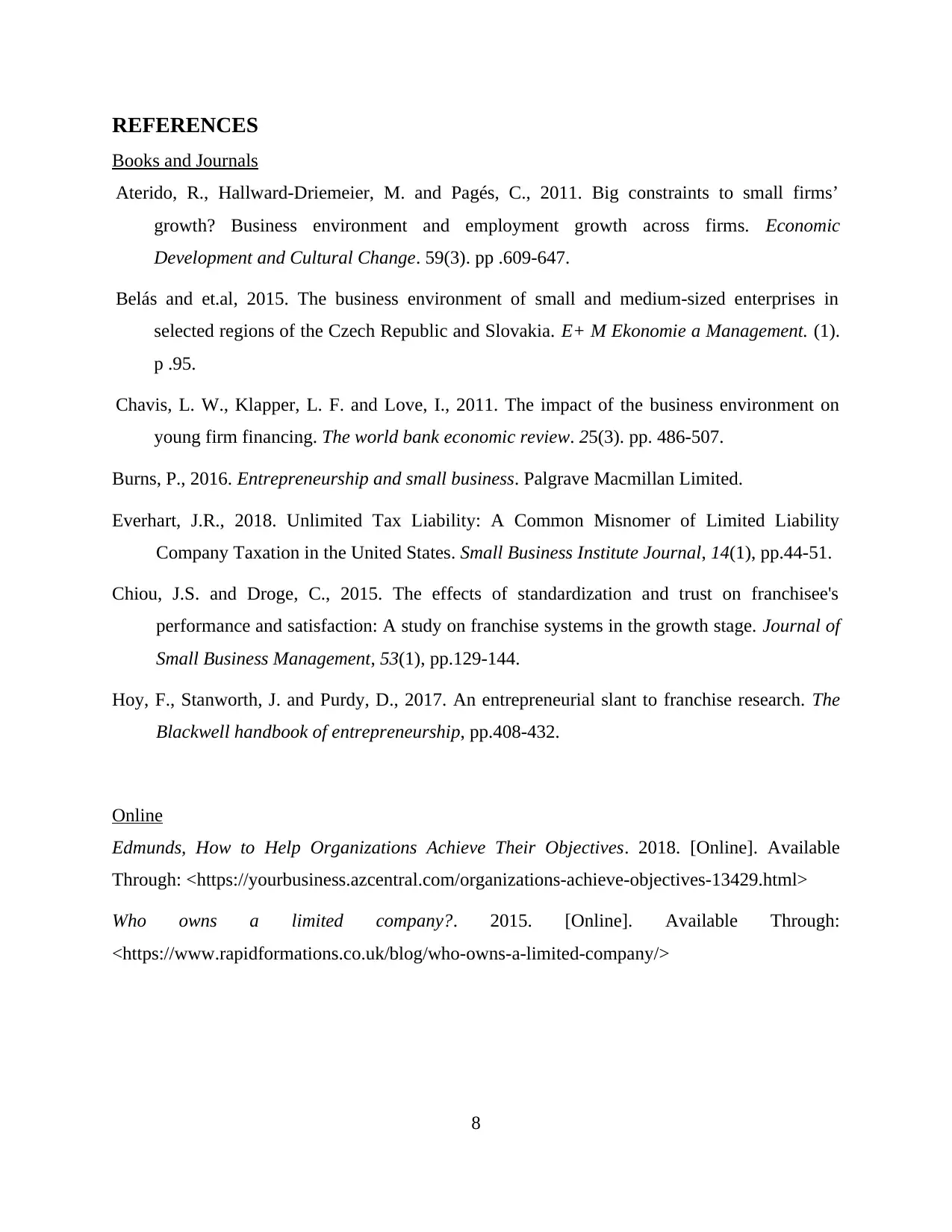
REFERENCES
Books and Journals
Aterido, R., Hallward-Driemeier, M. and Pagés, C., 2011. Big constraints to small firms’
growth? Business environment and employment growth across firms. Economic
Development and Cultural Change. 59(3). pp .609-647.
Belás and et.al, 2015. The business environment of small and medium-sized enterprises in
selected regions of the Czech Republic and Slovakia. E+ M Ekonomie a Management. (1).
p .95.
Chavis, L. W., Klapper, L. F. and Love, I., 2011. The impact of the business environment on
young firm financing. The world bank economic review. 25(3). pp. 486-507.
Burns, P., 2016. Entrepreneurship and small business. Palgrave Macmillan Limited.
Everhart, J.R., 2018. Unlimited Tax Liability: A Common Misnomer of Limited Liability
Company Taxation in the United States. Small Business Institute Journal, 14(1), pp.44-51.
Chiou, J.S. and Droge, C., 2015. The effects of standardization and trust on franchisee's
performance and satisfaction: A study on franchise systems in the growth stage. Journal of
Small Business Management, 53(1), pp.129-144.
Hoy, F., Stanworth, J. and Purdy, D., 2017. An entrepreneurial slant to franchise research. The
Blackwell handbook of entrepreneurship, pp.408-432.
Online
Edmunds, How to Help Organizations Achieve Their Objectives. 2018. [Online]. Available
Through: <https://yourbusiness.azcentral.com/organizations-achieve-objectives-13429.html>
Who owns a limited company?. 2015. [Online]. Available Through:
<https://www.rapidformations.co.uk/blog/who-owns-a-limited-company/>
8
Books and Journals
Aterido, R., Hallward-Driemeier, M. and Pagés, C., 2011. Big constraints to small firms’
growth? Business environment and employment growth across firms. Economic
Development and Cultural Change. 59(3). pp .609-647.
Belás and et.al, 2015. The business environment of small and medium-sized enterprises in
selected regions of the Czech Republic and Slovakia. E+ M Ekonomie a Management. (1).
p .95.
Chavis, L. W., Klapper, L. F. and Love, I., 2011. The impact of the business environment on
young firm financing. The world bank economic review. 25(3). pp. 486-507.
Burns, P., 2016. Entrepreneurship and small business. Palgrave Macmillan Limited.
Everhart, J.R., 2018. Unlimited Tax Liability: A Common Misnomer of Limited Liability
Company Taxation in the United States. Small Business Institute Journal, 14(1), pp.44-51.
Chiou, J.S. and Droge, C., 2015. The effects of standardization and trust on franchisee's
performance and satisfaction: A study on franchise systems in the growth stage. Journal of
Small Business Management, 53(1), pp.129-144.
Hoy, F., Stanworth, J. and Purdy, D., 2017. An entrepreneurial slant to franchise research. The
Blackwell handbook of entrepreneurship, pp.408-432.
Online
Edmunds, How to Help Organizations Achieve Their Objectives. 2018. [Online]. Available
Through: <https://yourbusiness.azcentral.com/organizations-achieve-objectives-13429.html>
Who owns a limited company?. 2015. [Online]. Available Through:
<https://www.rapidformations.co.uk/blog/who-owns-a-limited-company/>
8
1 out of 10
Related Documents
Your All-in-One AI-Powered Toolkit for Academic Success.
+13062052269
info@desklib.com
Available 24*7 on WhatsApp / Email
![[object Object]](/_next/static/media/star-bottom.7253800d.svg)
Unlock your academic potential
Copyright © 2020–2025 A2Z Services. All Rights Reserved. Developed and managed by ZUCOL.




